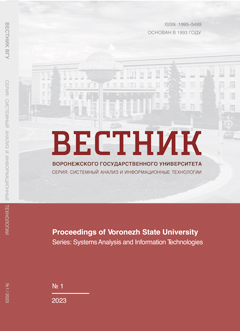Синтез систем управления с прогнозирующей моделью группой специалистов различного профиля
Аннотация
Работа направлена на систематизацию решения задачи выбора структуры прогнозирующей модели, используемой при управлении. Во вводной части работы рассмотрены подходы к моделированию, основанные на требованиях и на данных. Рассмотрены распространенные способы уменьшения влияния на качество управления смещения прогноза модели. Показано, что быстрые изменения состояния процесса требуют обратить внимание на проблемы самой модели. Проблемы обусловлены свойствами ретроспективных данных о технологическом процессе в условиях возмущений. В работе рассмотрена проблема человеческого фактора при структурной идентификации моделей, обусловленная привлечением специалистов разных направлений к процессу синтеза системы управления и самой модели. При этом допускается, что выполнение работ специалистами может осуществляться асинхронно в течение разных временных интервалов. С учетом этого определены этапы деятельности специалистов при синтезе прогнозирующих моделей в контексте концепций цифровых двойников и холонического управления. Предложенные этапы деятельности демонстрируют антагонизм подходов к моделированию основанных на данных и на требованиях и определяют пути согласования свойств модели с целями моделирования. В заключительной части приведены два примера, демонстрирующие применение подхода основанного на данных в ситуациях, когда использование подхода основанного на требованиях затруднено. В примерах рассмотрен процесс совершенствования модели и согласования с задачами управления. Первый пример посвящен задаче управления качеством железорудного агломерата. Во втором примере рассматривается управление температурой стальной полосы при горячем оцинковании.
Скачивания
Литература
2. Juan Manuel Davila Delgado and Lukumon Oyedele (2021). Digital Twins for the built environment: learning from conceptual and process models in manufacturing. Advanced Engineering Informatics. 49. 101332. DOI
3. Andrievsky B. R. and Furtat I. B. (2020) Disturbance observers: methods and applications. I. Methods. Automation and Remote Control. 81(9). P. 1563–1610.
4. Elragal A. and Klischewski R. (2017) Theory-driven or process-driven prediction? Epistemological challenges of big data analytics. J Big Data 4. 19. DOI
5. Christopher C. Drovandi, Christopher C. Holmes, James M. McGree, Kerrie Mengersen, Sylvia Richardson and Elizabeth G. Ryan. (2017) Principles of Experimental Design for Big Data Analysis. Statist. Sci. 32 (3). P. 385–404. August 2017.DOI
6. Wolfgang Maass and Veda C. Storey. (2021) Pairing conceptual modeling with machine learning. Data & Knowledge Engineering. 134. 101909. DOI
7. Amir Sakka, Sandro Bimonte, Stefano Rizzi, Lucile Sautot, Franзois Pinet, Michela Bertolotto, Aurйlien Besnard and Noura Rouillier (2021) A profile-aware methodological framework for collaborative multidimensional modeling. Data & Knowledge Engineering. P. 131–132. 101875, DOI
8. Lemeshko B. Yu., Lemeshko S. B. and Semenova M. A. (2018) To question of the statistical analysis of big data. Tomsk State University Journal of Control and Computer Science. 44. P. 40–49.
9. Yuxin Wen, Jianguo Wu, Devashish Das and Tseng, Tzu-Liang (Bill). (2018) Degradation modeling and RUL prediction using Wiener process subject to multiple change points and unit heterogeneity. Reliability Engineering and System Safety. Vol. 176, issue C. P. 113–124.
10. Han M., Li W., Feng S., Qiu T. and C. L. P. Chen (2021) Maximum Information Exploitation Using Broad Learning System for Large-Scale Chaotic Time-Series Prediction. IEEE Transactions on Neural Networks and Learning Systems. June 2021. Vol. 32, No 6. P. 2320–2329. DOI
11. Zhang G. Peter and Qi Min (2005) Neural network forecasting for seasonal and trend time series. European Journal of Operational Research. 160. P. 501–514
12. Fatehi A., Sadjadian H., Khaki-Sedigh A. and Jazayeri A. (2008). Disturbance Rejection in Neural Network Model Predictive Control. IFAC Proceedings Volumes. 41. P. 3527–3532.
13. Cunsong Wang, Zhenghong Zhu, Ningyun Lu, Yuehua Cheng and Bin Jiang (2021) A data-driven degradation prognostic strategy for aero-engine under various operational conditions Neurocomputing. Volume 462. 28 October 2021. P. 195–207. DOI
14. Linkan Bian and Nagi Gebraeel (2014) Stochastic modeling and real-time prognostics for multi-component systems with degradation rate interactions. IIE Transactions. 46:5. P. 470–482. DOI
15. Linkan Bian, Nagi Gebraeel and Jeffrey P. Kharoufeh (2015) Degradation modeling for real-time estimation of residual lifetimes in dynamic environments. IIE Transactions. 47:5. P. 471–486. DOI
16. Wang H., Liao H. and Ma X. (2021) Remaining Useful Life Prediction Considering Joint Dependency of Degradation Rate and Variation on Time-Varying Operating Conditions. IEEE Transactions on Reliability. 70(2). P. 761–774. DOI
17. Mohammadmahdi Hajiha, Xiao Liu and Yili Hong (2021) Degradation under dynamic operating conditions: Modeling, competing processes and applications. Journal of Quality Technology. 53:4. P. 347–368. DOI
18. Pannocchia G. and Rawlings J. B. (2003) Disturbance models for offset-free model-predictive control. AIChE J. 49. P. 426–437. DOI
19. Bandara K., Bergmeir C. and Hewamalage H. (2021) LSTM-MSNet: Leveraging Forecasts on Sets of Related Time Series With Multiple Seasonal Patterns. IEEE Transactions on Neural Networks and Learning Systems. 32(4). P. 1586–1599. DOI
20. Kiara Ottogalli, Daniel Rosquete, Aiert Amundarain, Iker Aguinaga, Diego Borro (2019) Flexible Framework to Model Industry 4.0 Processes for Virtual Simulators. Appl. Sci. 9. 4983. DOI
21. Gilberto Pérez Lechuga, Francisco Martínez Sánchez (2018) Modeling and Optimization of Flexible Manufacturing Systems: A Stochastic Approach, ICO 2018, AISC 866, P. 539–546, 2019. DOI
22. Stefan Kern, Johannes Scholz (2020) Agent-Based Simulation for Indoor Manufacturing Environments–Evaluating the Effects of Spatialization, Geospatial Technologies for Local and Regional Development. Lecture Notes in Geoinformation and Cartography. P. 309–324. DOI
23. Mohd. Shaaban Hussain, Mohammed Ali (2019) A Multi-agent Based Dynamic Scheduling of Flexible Manufacturing Systems. Global Journal of Flexible Systems Management. 20(3). P. 267–290. DOI
24. Andreas Kokkas, George-Christopher Vosniakos (2019) An Augmented Reality approach to factory layout design embedding operation simulation. International Journal on Interactive Design and Manufacturing. DOI
25. Rudin C. (2019) Stop explaining black box machine learning models for high stakes decisions and use interpretable models instead. Nat Mach Intell 1. P. 206–215. DOI
26. Ryabchikov M. Y. and Ryabchikova E. S. (2021) Big Data-Driven Assessment of Proposals to Improve Enterprise Flexibility Through Control Options Untested in Practice. Glob J Flex Syst Manag. DOI
27. Shinyoung Kwag, Bu Seog Ju (2019) Application of a Bayesian hierarchical model to system identification of structural parameters. Engineering with Computers. DOI
28. Dandan Feng, Zhanfeng Deng, Tongxun Wang, Yingying Liu, Lingling Xu (2018) Identification of disturbance sources based on random forest model. 2018 International Conference on Power System Technology. P. 3370–3375.
29. Ginsberg K. S. Problema strukturnoj identifikacii dlya celej proektirovaniya sistemy avtomaticheskogo upravleniya [The Problem of Structural Identification for the Purposes of Designing an Automatic Control System]. Proceed-ings of the X International Conference «System identification and control» SICPRO ’15. P. 43-80. (in Russian)
30. Mourad Elloumi, Afef Ghanmi, Samira Kamoun (2018) Structural parameter identification approaches for interconnected nonlinear systems. 15th International Multi-Conference on Systems, Signals & Devices (SSD). P. 334–339.
31. Ginsberg K. S., Genkin A. L. (2017) On the structure identification scientific methodology foundations for the purpose of creation of real automatic control systems with required properties. Cherepovets State University Bulletin. (3). P. 24–30. (in Russian)
32. Genkin A. L., Ginsberg K. S. (2017) To the problem of structure identification for the purpose of creation of real automatic control system with required properties. Cherepovets State University Bulletin. (6). P. 19–24. (in Russian)
33. Ginsberg K. S. (2002) A new approach to the problem of structural identification. II. Automation and remote control. 63(6). P. 946–959.
34. Taguchi Y., Hino H. and Kameyama K. (2021) Pre-Training Acquisition Functions by Deep Reinforcement Learning for Fixed Budget Active Learning. Neural Process Lett 53. P. 1945–1962. DOI
35. Jose-Fernando Jimenez, Gabriel Zambrano-Rey, Santiago Aguirre and Damien Trentesaux (2018) Using process-mining for understating the emergence of self-organizing manufacturing systems. IFAC Papers On Line 51-11. P. 1618–1623.
36. Ghazaleh Khodabandelou, Charlotte Hug, Rebecca Deneckère, Camille Salinesi (2013) Process Mining Versus Intention Mining, Conference Paper. Lecture Notes in Business Information Processing. DOI
37. William Derigent, Olivier Cardin, Damien Trentesaux (2020) Industry 4.0: contributions of holonic manufacturing control architectures and future challenges. Journal of Intelligent Manufacturing. DOI
38. Ryabchikov M. Y. and Grebennikova V. V. (2013) Simulation of the combined effect of production factors on metallurgical sinter mechanical strength. Metallurgist. 57(3–4). P. 274–283.
39. Ryabchikov M. Yu., Grebennikova V. V., Ryabchikova E. S. and Bogdanov N. V. (2016) Problems of quality management of metallurgi-cal agglomerate on the basis of results of opera-tional x-ray fluorescent analyses. Quality and life. 2 (10). P. 13–20. (in Russian)
40. Ryabchikov M. Yu. (2018): Metallurgical agglomerate quality management with the account of its impact on the blast-furnace process efficiency. The International Journal of Advanced Manufacturing Technology. V. 94, No 9-12. P. 3785–3794.
41. Ryabchikov M. Y., Ryabchikova E. S., Shmanev D. E. and Kokorin I. D. (2021) Strip cooling control for flexible production of galvanized flat steel. Steel in translation. 51(7). P. 446–455.
- Авторы сохраняют за собой авторские права и предоставляют журналу право первой публикации работы, которая по истечении 6 месяцев после публикации автоматически лицензируется на условиях Creative Commons Attribution License , которая позволяет другим распространять данную работу с обязательным сохранением ссылок на авторов оригинальной работы и оригинальную публикацию в этом журнале.
- Авторы имеют право размещать их работу в сети Интернет (например в институтском хранилище или персональном сайте) до и во время процесса рассмотрения ее данным журналом, так как это может привести к продуктивному обсуждению и большему количеству ссылок на данную работу (См. The Effect of Open Access).



















